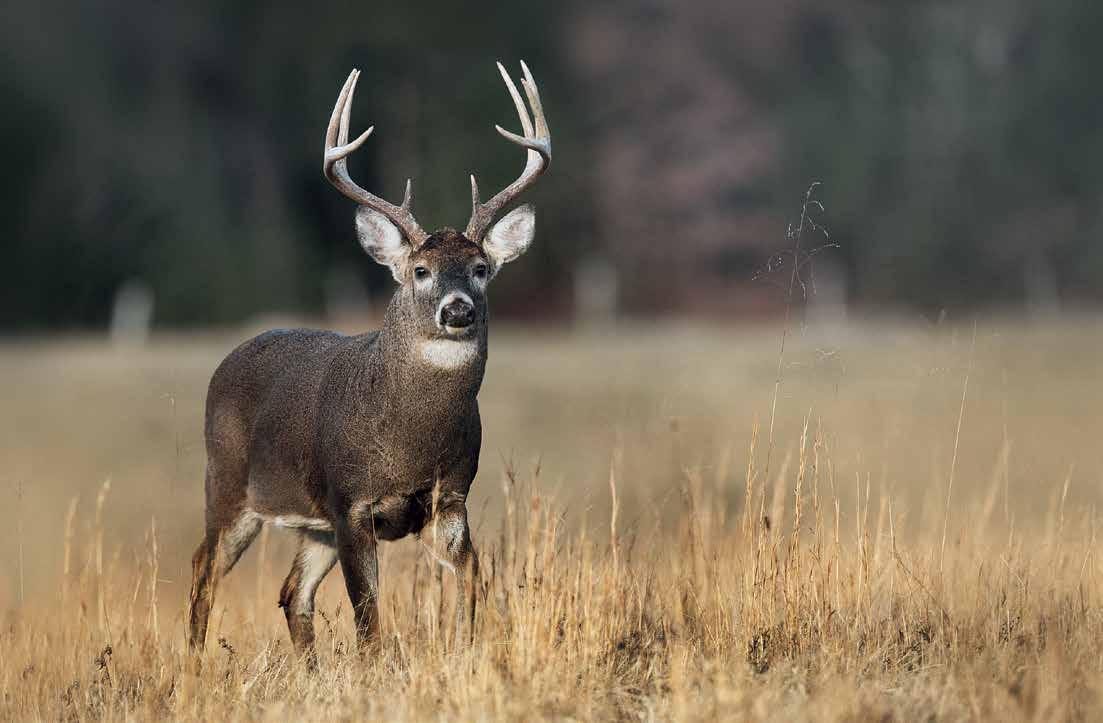








Sprung - nine startled red deer mill about like headless chooks. They gather their wits and dash into the gorse above the forest track just as I get the ute parked and the rifle readied. A brown-eyegoodbye their Cervus version of ‘adios cowboy!’
The hinds hadn’t interested me, they were all bellies a’ bulge and bagged up with colostrum. With a gut full of freshly foraged greenery, they were toting a lot of weight, including a fully formed fawn. Nope it was not the big mamas I had my eye on, it was one of their last season’s sons. He with the velvet spikes carried tall and proud and his summer coat just emerged from its winter wardrobe.
The following morn I made like Mr Schwarzenegger –‘I’ll be back’ – but this time my ute was a kilometre away and I was stealthing along in soft boots and with rifle at the ready.
Dawn had clambered through the great divide and the natural world was abuzz
with life. Sunday-morninghumans though, were a whole other story. Their homes and lifestyle blocks were across the river, dotted along the terrace at regular intervals. Of the humans, no one was stirring, not a yawn nor a fart broke the silence.
A thrush fluttered from a culvert head; she’d used the wee pool there to perform her morning ablutions. Feathers slicked back, sleepy eyes clear and teeth brushed she started her day in fine style. Quail pairs with bumble bee-sized chicks hurried as quail do, picking at grit and tugging seeds from tall grasses. Birds of every variety were singing up a storm.
A French hen in a coop across the way started to cluck. An early bird, she’d just produced an egg and told everyone within ear shot all about it.
That’s when the roosters started.
As I padded along silently every rooster at every residence across the river stretched his neck and his vocal cords too. A cock-adoodle-doo at every house. The second-last place had two!
Noise pollution and no deer over here. Whilst over there, the Sunday-morninghumans slept on, curtains pulled, and alarms muted. It was the turkey that did it. At the eighth house up the valley a turkey tom started to contribute his vocalisations to the domestic fowl dawn chorus. His enthusiastic ‘gobble-gobble-gobble’ did my head in. What next - two turtle doves and a partridge in a pear tree?
I detoured far from the forest track, following the tinkling tones of a side creek. Here, clover grew lush despite summer’s dry and lanky watercress flowered prolifically. Buttercup, broom and barberry competed for ‘Best in Show in the Yellow Flower’ category.
This was more like it. Absolute silence except the sounds of the birds and the bees. Now I could tune-in without distraction and be aware of all things in the natural environment. Eventually a movement caught my eye. A flash of black amidst a broom bush. Probably a blackbird gobbling flowers. Possibly a pig, also eating flowers.
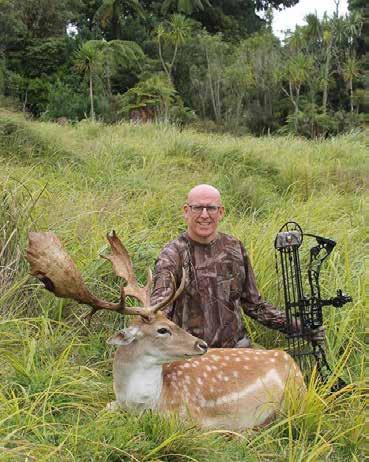



here in New Zealand. We’ve refined the latest string building techniques, equipment, and materials we use through constant field testing to get the string quality we’re excited about.
Go Kiwi with all black or choose from thousands of colour combinations with clear serving to customise it your way.
Pre-stretched for zero peep rotation, with speed buttons installed and a bow tune, we’ll send your bow back to you shooting as good as new, maybe even better!
 Kim Swan
Kim Swan
I paused, waited, watched intently. The odd glimpse was enough to ascertain it was no blackbird. Nor was it a porker – too tall.
It was velvet. Black velvet. I slowly, s-l-o-w-l-y crept crossways to open the shooting angle, then I just managed to sink to one knee before an ear and an eye appeared below the velvet. I readied myself to shoot, still on one knee, like I was about to make a marriage proposal. The head kept moving, the velvet bobbing back and forward as the buck picked flowers with his lips. Through my scope I could see his long eyelashes, his moist nose, the flu in his ears but I didn’t want to risk
a head shot on a bobbing target.
I waited - till my arms began to tire of holding the raised rifle.
I waited longer - the buck vanished - then his head reappeared - still eating. My knee-high thigh began to cramp and my arms to tremble. I could hear my heart and feel it too. I could hear the pluck and chew and swallow as the buck fed. But I couldn’t shoot yet. Patience. Wait!
Finally, after eons, a fine black fallow buck stepped forward, his chest in full view. My fatigued arms wouldn’t behave, the rifle barrel wandered, the view through the scope weaved

Most of my spare time has involved hunting of one description or another, from dedicated pig hunter to deer stalker to dabbling in duck and alpine hunting - a bow had never seriously been on the agenda.
25 years ago, I picked up a mate’s bow, flicking a few arrows at a target that was luckily large and close proved to me that it was both a challenge and really satisfying when everything came together. The arrow went close to where I had aimed.
Seven years ago – using the magic of trade me I purchased my own bow. Then things started getting interesting; the advent of Google and You Tube allowed for some selftutoring and a very steep learning curve, learning that I had no idea how to correctly operate what, at face value, appeared a straightforward piece of equipment.
That first bow was luckily highly adjustable, and after some trial and error, the groups on the target at
and wobbled. My mind was doing 110kph, my heart 150bpm. I’m old enough to know better, but adrenalin and anticipation were, as always, a very intoxicating cocktail.
The shot was accurate, but the buck ran anyway. He leapt a redundant barbed wire fence, airborne like the finest showjumper. He clattered across the creek, droplets of both water and blood in his wake. He made the shelter of the forest then lay down, defeated. I gave him a moment to expire in peace, his eyes dulled and reflexes ceased. I padded silently back towards my ute, recounting the fine stalk in my head while retracing my boot prints in the dust. The roosters had shouted themselves to a stand-still, but the turkey gobbler continued his racket. He has no clue, how can he, that Christmas is but days away and he is destined to take pride of place at the family dining table. Thanks be to that turkey for giving me reason to detour. Now my table and theirs will be graced with fine Christmas fare.

home became smaller and more acceptable at further ranges.
This steep learning could have been short-circuited by using the available experts. Advanced Archery have been invaluable in their advice and service, and I strongly recommend anyone interested in getting started to use their experience and skill.
The opportunity to get close to wild animals of all types, from small game through di erent species of deer and alpine species, has proved a very enjoyable and rewarding challenge.
As I have gotten older, it has become more about the experience than bringing meat home. Add in using a bow, and another whole level of challenge arrived, not just to get close, but get close , then work through all that is involved: distance, angle, raise and draw the bow, sight e ectively with the animal in the clear presenting a suitable shot angle all while staying undetected and then execute an ethical shot. It isn’t easy, but it is most definitely rewarding and exciting.
For those who are interested in bow hunting, seek out advice and make use of the skill that others have gained, often the hard way; I have yet to meet a bow hunter who is not prepared to help someone who is keen to learn. When it all comes together, it is an experience that cannot be beaten. That first animal taken with a bow is one that you will not forget, but that is another story.
After a tough year of fishing down in Christchurch, the desperation to catch snapper again had truly set in. With only a couple of days spare at the top of the south, I knew I would
have to make the most of it.
As luck would have it, the weather had other plans and “sunny Nelson” had decided to rain cats and dogs for the whole week I was there. However, this didn’t change my plans because, as we all know, fish don’t really care if it’s
 Sam Boothroyd
Sam Boothroyd
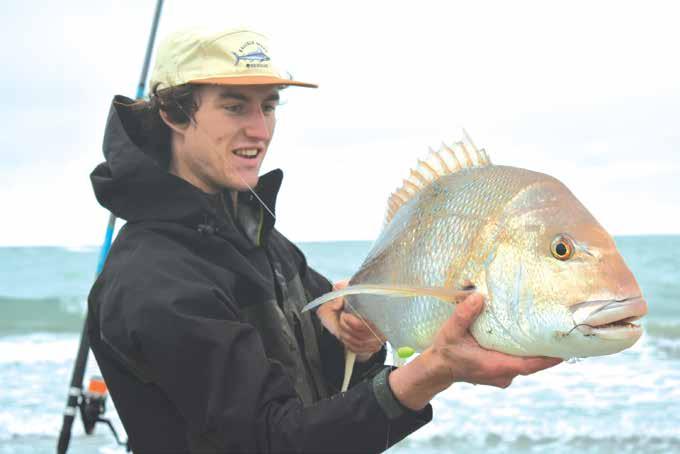
raining; they’re already wet. So, with this strange philosophy in my back pocket, along with unbridled enthusiasm and a good raincoat, I set out to catch my much-needed snapper.
Several hours later, I stood soaked to the bone and appeared like a drowned rat, but I wasn’t ready to give up yet. Sure enough, just as the thoughts of dry



clothes and a hot drink were beginning to tempt me, my rod buckled straight towards the surf.
The fight was textbook snapper with powerful runs and reel-screaming headshakes, but I refused to get my hopes up; this spot had yielded plenty of eagle rays who had also convinced me that they were, in fact, of another
species. After several nervous minutes of fighting, I spotted Fergus sprinting down the beach to enjoy the show. Between us, we convinced ourselves it had to be a snapper, so when an absolute barn door of a snapper flanked in a wave, we were practically ecstatic. Carefully, I slid it up through the waves, where Ferg pounced on it.
At 17 pounds and well over 75cm, it was a magnificent specimen, and to catch such an awesome snapper o the shore in the South Island is unreal. I’m bloody stoked to have ticked it o . Having said that, to prove it wasn’t just a random stroke of luck, I am now forced to spend as much time as possible trying to catch the magic 20-pounder o the shore.






If you’re heading into Fiordland this summer, set aside time to familiarise yourself with the fishing rules and get your device ready to record your catch. Popular species including blue cod, pāua and hapuku/groper require rebuilding, and that is going to require the whole community to get onboard.
New amateur fishing
of the fishing community raised concerns about the sustainability of fisheries under the current rules.
The new regulations will establish a Fishing Line across the headlands of each fiord, and bag and daily species limits will be set to incentivise fishing activity on the open coast. This is a move to protect more vulnerable stocks and to encourage fishing e ort on the most productive grounds that exist on the open coastline. The new settings will still allow fishing
and responsive way. With the imminent change to Fiordland’s amateur fishing rules, and the development of the reporting app Mainland Catch, it is time to act.
With data comes power, and that couldn’t be more relevant than with fisheries management. The Guardians and Fisheries New Zealand are making management decisions in an environment of some uncertainty. By reporting your fishing e ort and catch, we will be in a stronger

regulations and bag limits for the Fiordland Marine Area are expected to be in place next month (Jan 2024) following four-years of information gathering, proposals and consultation. The Fiordland Marine Guardians began this process after members
inside the fiords, but at a lower level.
A message that the Guardians heard loud and clear from the recreational fishing community is that you want to start contributing your fishing data so we can manage the fisheries in a more informed
Things are looking better with the formation of the new Government. This is going to be a great opportunity for New Zealand to have the best firearm laws in the world.

support recreational fishers when they are consulted on any future management proposals.
As Fish Mainland say, “The benefit for fishers is that better data informs management decisionmaking". In other words, the benefit is in providing a basis for action or a recommendation to improve fisheries that are important to recreational fishers.”
One feature of the new rules is the introduction of tiered daily species limits and total bag limits according to which side of the Fishing Line you are on. This presents a challenge from a compliance perspective, because fishers will need to be able to provide information to support their claims of where fish were caught. This is where Mainland Catch can help. The app automatically records where each fish was caught, providing a straightforward means of demonstrating you are fishing within the rules.
Datacom are currently working on improvements to the app, so we advise getting the latest version before you head in.
Fish Mainland are confident that these improvements will take the app to the “next level”.
position to assess which direction stocks are heading in, and this will be able to be tuned to di erent parts of Fiordland. Also, for the first time we will all be able to get a sense of the collective fishing e ort by all fishers, across all sectors. This information will

head over those hills.
Take care out there, look out for each other, and please do your bit to look after this incredibly special place. We figure it’s a privilege to be able to enjoy Fiordland, and we all have a responsibility to ensure future generations can enjoy it too.
• visit www.fmg.org.nz
• get a clean vessel pass
• make a plan where to anchor
• familiarise yourself with the fishing rules
• check the weather forecast for Puysegur and Milford Sound/Piopiotahi.
There is still a large amount of work to be done by both those in and outside of Government. It is not going to be a quick fix, because unlike the last Government the plan is to do it right, which will involve talking to all parties and looking at evidence presented.
This is not the time to rush o and make more laws and changes like those done over the last four years, where feelings and ideology was the basis for them and a deep fear of talking to the experts.
The Clubs and Ranges
You can download Mainland Catch for free at www. fishmainland.nz or from your app store. Remember to download the app before you head in to the fiords as there is no mobile data coverage once you
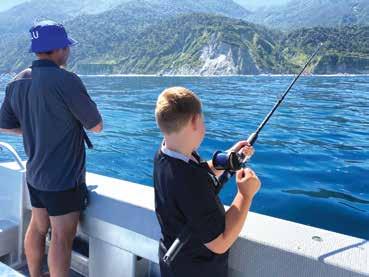
division of the police have put a huge amount of pressure on club volunteers all over the country, the problem is for all the hoops that they were making people jump through, this was not having any positive impact on safety improvements. Simply, there wasn’t a safety problem to fix.
Yes, occasionally something happens, but in most cases, these are self-inflicted and more to the point very rare. Especially when you take into consideration the number of hours spent by
a large group of people, and the number of rounds that are fired every week.
An example of this is at our recent IPSC pistol champs in November, more than 85,000 rounds were fired with no injuries.
Clubs are important as they give people a place to practice, test firearms and improve their skills by shooting under a controlled environment. Under the watchful eye of range sta , who in many cases o er the opportunity for further training and advice.
The way forward is to give all groups a chance to have
their say, ask them pointed questions and to respect answers, which have evidence backing them or real word experience, because we all want safer firearm laws. I just hope media coverage gives the system a fair hearing and publishes what is said and not put their spin on it. It has been my privilege to be involved in various groups that give up their own time, to advocate for our rights as licensed firearm holders. This is all done on a volunteer basis and many hours are involved.
November has rolled around & it’s time for another Dawnbreakers Fishing Club trip to Pohara. This is a popular fixture in the club’s calendar and is a great opportunity to get away with likeminded folks.
We arrived mid-afternoon on Friday, a quick unpack and then a catch up with an end of week drink, meeting across the road at Molly B’s for a fantastic meal followed by a makeshift fishing quiz created by yours truly. There was a little dissension in the ranks over my question regarding the Australian name for kahawai, resulting in a brief discussion on the merits of believing Wikipedia over Google!
Saturday saw most of our attending members heading out for a quick fish before the weather window closed. Not an overly successful session for most, but there were still a few nice fish brought home including a very nice 19lb Snapper. With most fishers back by lunchtime, nearly everyone made it to Anatoki Salmon. A beautiful setting, on a cracking sunny afternoon, it’s not a bad place to spend an hour or so (it can take
that long if the Salmon aren’t interested in your casting technique). The Bell boys arrived about half an hour after we started, five minutes later they had both landed fish!! And those who had beaten us there that morning had great success too in fairly brief time (resulting in the winning largest salmon for our mini competition over the weekend) – the ponds were well stocked!
We certainly weren’t in a rush and perhaps the fish weren’t too hungry, but around 45 minutes after we started, we had our fish in the bin. I felt a little nostalgic as we hadn’t been to Anatoki for around 18 years, since our eldest caught his first fish, in pretty much the same spot as my wife Catherine caught her first Salmon this trip. The fact that it was considerably bigger than mine wasn’t mentioned again for the rest of the weekend - yeah right!!
The café at Anatoki then provided the setting for a co ee/cold beverage & chat while our fish was getting smoked. My advice would be if you want to take ANY fish home, don’t try it when the box arrives at your table, once you start its very hard to stop.
Back to the Top Ten
campground, Nana-nap time, unfortunately this almost made us late for the BBQ tea and prize-giving – oops! Hard work this relaxing in the sun business! And lets not forget I’d been up and out early fishing.
Salads & sides from the members and a delicious selection of meat from Harris Farms & Wakefield Four Square had everyone happily fed.
Some great prizes awarded for the fish caught, and heap of spot prizes and a Bugga award handed out, this gave most of us a memento of the weekend.
Looking forward to the next one.
The Dawnbreaker’s Fishing Club is a great social, family focused club, that holds social days every month with 2-3 away trips a season. If you are interested in joining us – get in touch.
Phil Chilton President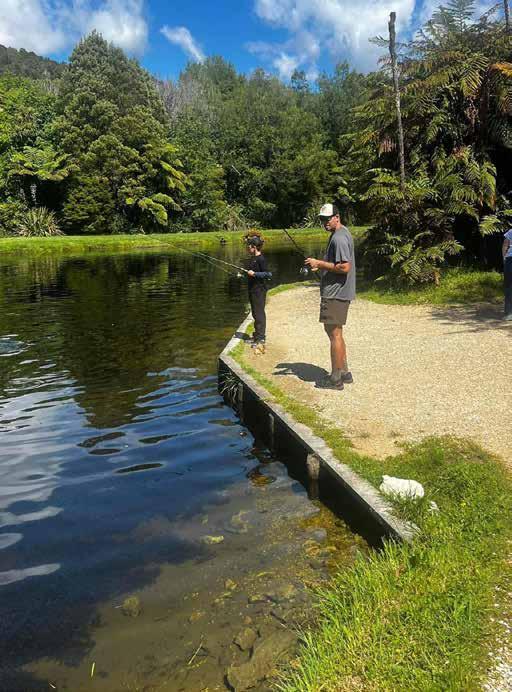 Phil Chilton
Phil Chilton







johnnytightlines


The story goes… Every year I look forward to chasing the searun trout we call “silver bullets!” Between late August and mid November is a prime time to target these guys in the lower reaches of most decent rivers.
The searun trout migrate up the rivers from the ocean to chase the whitebait and smelt.
They enter the river and present silver chrome , plump and feisty! Fantastic fighters that hit the lure hard and make searing deep runs that will have your reel screaming.
The eating quality is excellent with meat very similar in colour to salmon.
Use light mono or braid 6-8lb with 8lb fluorocarbon leader. Anything replicating a smelt will give you a good chance.
Lures such as Grey ghost , Cannibal trout, Berkley T tail olive, Veltec green / silver




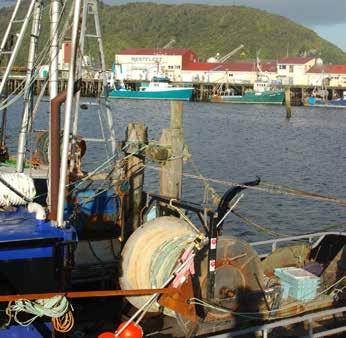
While discussing flat dinners one night, my flatmate mentioned that he loves mutton but hadn’t eaten any all year as a leg of lamb can cost over $50! Way too expensive for a uni student. Luckily, I knew of a spot not far from Dunedin that was overpopulated with wild sheep.
Armed with my .223 and a day pack, I set o to score some cheap meat and fight the cost of living. Dapples scattered the forest as the sun slowly emerged through the dense canopy. I meticulously stalked through the thick native forests, intensely searching around me and checking the ground for signs of life. Amongst the crown fern and leaf litter, I picked up on some fresh deer droppings and footprints. The amount
of sign indicated the deer population was more than healthy so I slowed down, stopping every 10 metres to scan my surroundings—I knew it wouldn’t be long until I bumped into an animal.
Only 15 minutes after seeing the deer sign, something caught my attention. Like a spotlight
Daniel Crimpon stage, a beam of yellow light shone through the trees directly onto a deep orange figure. Only 25 metres away stood a young red spiker, staring at me. On any other hunt the deer would be on the ground by now but this time he was safe because he wasn’t white and woolly. He quickly vacated and left me
to carry on with my mission. As I stalked further into the bush, the deer sign decreased and I began to see signs of my target species. The forest was now far more open, meaning I could move easier and see further ahead.
Suddenly, the songbirds were interrupted by an
arrogant “baaa.” I turned to face the direction the sound came from and saw a flash of white moving through bushes in the distance. The wind was perfect and there was enough cover to attempt a good stalk. I slowly put one foot in front of the other and, before I knew it, I was within 15 metres of the sheep. It was


range 222 through to 30-06
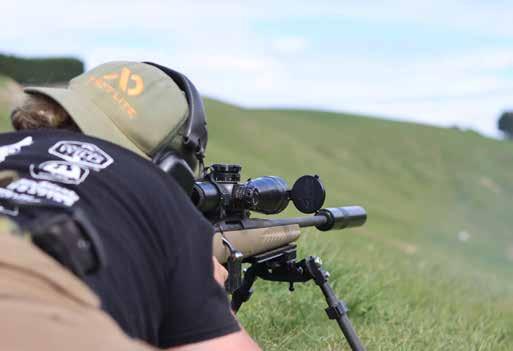
We have two multi calibre suppressors available in the hybrid model and this is possible because the hybrid ba e system has tight tolerances allowing the small ranges of calibre. The hybrid ba e system also lowers the risk of stray bullets and bullet strike
• The first is suitable for 22 Hornet through to 243 including, 222, 223, 22-250, 243.
• The second suppressor is suitable for 6.5 through to 30-06 including 6.5 prc, 270, 7mm-08, 284, 280, 308, 7.62 x 39 etc (not including 300 PRC or belted magnums).
• 9” in length (230mm), sits 4” forward & 5” back over the barrel (this is a “fixed” length and cannot be changed or added to)
• Weight 360 – 370grams (alu internal muzzlebrake 5-6,000 rnds)
• Colour - Black
The 41mm 9” suppressor is most suited for those who like to clean their suppressor.
If you are a lover of the New Zealand outdoors and of adventurous challenges then this is the book for you, or the perfect gift for someone who is. “You don’t have to be a millionaire or a world beater. You just have to be made of stern stu and have a sense of adventure.”
Author, Ray Salisbury, has selected eleven particularly challenging and noteworthy forays into the extreme corners
of New Zealand, and some of New Zealand’s most memorable extreme athletes - Graeme Dingle & Jill Remain, Paul Ca yn, Steve Gurney, Brando Yelavich and Lisa Tamati feature . The people followed in this book all fully deserve a place in New Zealand’s history books. For that reason alone this book is a keeper, or as a wonderful gift for growing family members with a love of outdoor adventures.
One minute you are paddling a kayak against a tidal rip, the next frozen near death on a mountain top or bushwhacking the
completely unaware that I was there so I raised my rifle, closed the bolt, and squeezed the trigger. The sheep dropped instantly and the bush around it erupted. That lone sheep was actually part of a mob of 10 that were now darting in every direction. Without thinking, I reloaded the rifle and swung the crosshairs on the one sheep that wasn’t sprinting away. A confused ewe stood 20 metres away, unsure what had happened or what to do. Amongst the commotion, the .223 spoke loudly and the ewe collapsed only a few metres from the first.
I boned out all the meat I could fit in my backpack and cruised back home, smiling ear to ear.
I was greeted by a very happy flatmate, who now had a few hundred dollars worth of free-range mutton for less than $50 worth of petrol.
Te Araroa Trail alone.
One particular chapter that stood out for me was “Wildboy’ when 19 year old Brando Yelavich takes on a challenge to try and overcome his dyslexia and ADHD by doing a complete circumnavigation around the NZ coastline on his own. As Ray says “ this is the story of a boy becoming a man”. Another feature of this book are the Appendices (NZ Traverses) & (Kayak Circumnavigations).
The Index is significant - “people and places of adventure”. Definitely a perfect addition to your personal collection.





Daryl Sykes a regular correspondent for the industry provides a brief overview of the challenges and opportunities facing a new Minister of Fisheries in 2024 and beyond.
It’s Christmas, and right behind it is New Year 2024. The Chinese will celebrate that as the Year of the Dragon (the house and street parties start on February 10th), but for us in New Zealand, it will be the first full year of a new Government, and the fishing fraternity also gets to see how a new Minister will respond to the many fisheries issues that were either or both ignored or poorly managed by the previous incumbents.
First to the new Minister.
The Honourable Shane Jones needs little introduction, and for those who may not know other than his historical headliners, he is an astute, quick-witted, deft politician, a superb orator and has an intense personal interest in regional issues.
Jones’s political career began in 2005 as a list MP for the Labour Party.
He briefly held various senior positions before Labour was relegated to an opposition party in 2008. In 2013, Shane unsuccessfully contested the leadership of the Labour Party and subsequently left Parliament in 2014 for a brief diplomatic posting. Upon his return to New Zealand, his political allegiance switched to New Zealand First.
Shane held ministerial portfolios for regional economic development and forestry until 2020. Following on from the coalition government agreements in 2023, Shane is now Minister for Oceans and Fisheries, Minister for Regional Development, and Minister for Resources. He is no stranger to fisheries issues at a high level, having been a chairman of Sealord for a period and later was appointed by National’s Minister of Foreign A airs Murray McCully as a fisheries economic ambassador, working to help Pacific islands get the most from their fisheries.
We have not yet seen the full suite of policy scripts for Oceans and Fisheries as set out in the coalition agreement. Still, it is very possible that Minister Jones will be casting a critical eye over the current state of the fishing industry
and the tensions that arise as a consequence of a prolonged failure to e ectively manage fishing.
The Minister has been around long enough to appreciate that New Zealand adopted a rights-based fisheries management regime in 1986. He is astute enough to realise now that the system has been neglected, compromised, and mischaracterised and has failed to meet a number of the foundation objectives anticipated by the 1986 policymakers and politicians. The failures are essentially bureaucratic and administrative and occur across several Government agencies. I have argued in the past that for too long, the New Zealand Fisheries Management regime (which, by the way, is not just the Quota Management System) has lacked a credible champion, or indeed champions, and that Government agencies have failed the policy settings that would have enabled better fisheries outcomes than we have to live with today.
Over the years, somewhere in several agency back rooms, amongst a succession of self-serving bureaucrats, managing fishing just became too hard. Rather than stand on the credibility and potential of the legislated rights-based regime and implement e ective strategies, the agencies opted for the most politically expedient positions. The media reputation of several agencies took priority over their e ciency, e ectiveness, and competency – all wins were widely and colourfully reported; all losses and squandered opportunities were ignored.
The fishing community at large has been the loser, but so too have some particular fishing sectors. There are some spectacular contemporary examples, so let’s briefly go from south to North.
In Otago, a South East Marine Protection Plan has been announced. It has its origins as a vanity project initiated by a former Minister of Conservation, Nick Smith. The Plan has been controversial from the outset, and the recent response from fishing communities was both fast and somewhat furious as it had been for years. Back in 2018, Tautuku Fishing Club president Brett Bensemann said the wishes

of recreational fishermen had been overlooked in favour of environmentalism.
In the same media report, commercial fishing spokesperson Simon Gilmour strongly objected to the planning process, noting the absence of any coherent risk assessment and the lack of recognition of existing reserves and well-established and
and hand over authority to an obviously well-meaning but, in fishery management terms, poorly resourced local community group?
Head across to the Bay of Plenty and witness the loss of fishing access due to rules being introduced to protect indigenous biodiversity and acknowledge the significant marine, landscape and

sustainable fishing practices. Their complaints fell on deaf bureaucratic ears.
In Taranaki, a 70km stretch of coastline is now under the e ective control of a hapū that, in November 2023, won an Environmental Award for their initiative. A spokesman commented that he hoped the Rāhui Tīma could be extended to allow time for a mātaitai, or customary reserve, to be established where commercial fishing was banned, and hāpu will recommend by-laws on customary and recreational catches.
The Rāhui Tīma was an understandable response to decades of pillaging inshore shellfish, particularly intertidal shellfish, bought to a head by bus-loads (literally) of people from Auckland descending on the reefs between Opunake and Oakura.
How did the situation arise that enabled the relevant agencies to abandon shared fisheries policies
cultural values in the area. The three areas comprise what were accessible, productive and economically significant fishing grounds for all extractive users.
Further north into the Hauraki Gulf. The proposed Hauraki Gulf/Tīkapa Moana Marine Protection Bill includes:
Extending the country’s first marine reserve, Cape Rodney – Okakari Point Marine Reserve (Goat Island) and Whanganui A Hei (Cathedral Cove) Marine Reserve, on the Coromandel Peninsula
Creating 12 new highprotection areas to protect and restore marine ecosystems while allowing for customary practices of tangata whenua.
Five new seafloor protection areas to preserve sensitive seafloor habitats by prohibiting bottomcontact fishing methods and other activities which harm the seafloor.
If the provisions of the Bill are legislated,

fair warning or consultation mean all recreational and commercial fishing is banned from a part of the Bay of Islands and Mimiwhangata.
fishing will be crowded into ever-decreasing spaces with little apparent regard for the consequences of e ort shift and competition for available catch. But an issue being lost in this and other similar situations is how on earth we got to the point where closing areas to fishing became the primary management response.
One immediate answer is that the responsible agencies have consistently failed to e ectively manage fishing (including adverse method impacts on the environment).
Local communities understandably felt that if nothing was done, they would lose the quality of the marine environment they had long enjoyed. And now, they and we have pretty much lost access to fishing and ended up with a myriad of ocean aquaria.
There are other answers, the most likely being that fishing has simply become the ‘fall guy’ for all environmental problems observed in and around the Hauraki Gulf. It’s been a great diversion strategy for land-based polluters and those responsible for massive sediment run-o to support the e orts of the armchair eco fraternity to ban fishing.
And so to the far North - and back to the Shane Jones connections. Media reported in October 2023 that new no-take fishing rules imposed by the Environment Court without
Northland Regional Council adopted the rules in July after an earlier landmark Environment Court decision ruled fishing protection should be included in its Regional Plan – despite fishing not usually being managed by councils.
There are many casualties in all of this – legitimate recreational fishers, smallscale commercial fishing businesses important to local communities, charter fishing industry operators, gear suppliers, and larger commercial fishing interests who have collectively invested in the rebuild and maintenance of stock abundance in areas such as the CRA 2 fishery.
The Honourable Shane Jones, Minister of Oceans and Fisheries, will find a di erent agency landscape than he knew through his historical fishing links. The Ministry for Fisheries has been usurped and/or had its authority and responsibility greatly diluted as various well-funded anti-fishing and marine protection agendas have emerged since 1996. The rights-based fisheries regime, which the new Minister would fully acknowledge, gave rise to the Fisheries Settlement, matched with a proper focus on managing extractive removals from coastal fish stocks, which can enable what most sector representatives would regard as equitable shared fisheries outcomes. I hope we can all be confident that the new Minister will assert his experience and not allow the responsible fishing sectors to be further deprived of access and utilisation opportunities.
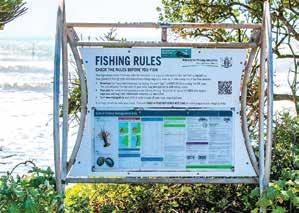
Unlike the rugby team, the springbok is cagey, agile and a worthy opponent. Like the rugby team, Kiwi’s love nothing better than to take down a springbok.
In many ways, these little antelopes are similar to our chamois: keen of eye, fleet of foot and possessing a higher IQ than a front row forward. However, with a beautiful specimen already on my den wall, it begged the question, “What next?” Answer. Hunt the colour variants!
While I’m more hunter than collector, the black
and copper springbok held aesthetic appeal to me because of their striking colours and elegant markings. Besides, they are just plain addictive to hunt, especially in the Greater Karoo. There is also a synergy to being species specific and extending the challenge.
My good friend and PH (professional hunter) Pete Wenham and I were hidden in the open of a vast plateau. Using the undulating landform, shadows, sparse clumps of vegetation and the odd donga or dry watercourse, we’d closed the gap on a herd of springbok to 400m!
Daryl Crimp
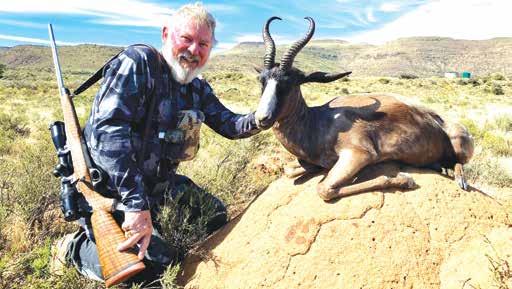

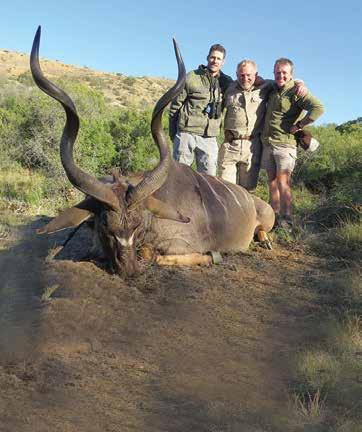
Springbok ‘salt & peppered’ the landscape but this cluster of a dozen held our attention because the patriarch was black—think ace of spades.
From our vantage, it was di cult to assess horn size but that was secondary; the value to me was in the quality of the hunt and the degree of di culty in outwitting a mature animal. And this buck was OLD. And cagey. Despite attempts to conceal ourselves, we were on the
herd’s radar and the old buck kept driving his harem ahead of us, around us, and upwind of us—always remaining the tiller on this desert ship.
This frustrating cat & mouse game was played out over two days and severely tested our mettle. It was only a bloody animal the size of a largish dog but it seemed to possess the ability to play chess, blow smoke and then vanish in a pu of the afore mentioned. We countered with various strategies, like dressing up as trees—I exaggerate— desert bushes resembling arthritic tumbleweeds!
Then, while reliving the days’ events over a sundowner, we realised the chink to our adversary’s armour was predictability; despite the tortuous route he took throughout the day, his disappearing act was from the same basin high up on the plateau. We were at a loss as to how he did it.
The following day, we played the same game until late in the piece and, ultimately, left the tracker as a decoy and fast paced it ahead of the perambulating herd—Mr ace of spades the Tillerman yet again. We climbed the dry cobbled
escarpment as the sun accelerated towards the horizon, aching with every footfall.
Once in place, Pete and I slipped into the shadow of some low bushes, me on the shooting sticks and Pete on the radio. The herd weren’t moving! They were feeding, confident in their own security. Pete instructed the tracker to make himself visible—nothing—make a noise—nothing—wave your bloody arms—nothing. The herd were relaxed and going nowhere.
But it was a ploy.
“There he is,” I whispered harshly!
Sneaking through a tiny saddle below us and repeatedly casting a backwards glance, the Tillerman played his ace— he’d decoyed the herd to make his escape. Pete whistled. The buck stopped and looked. I shot.
Anticlimax?
Hell no. Relief. Euphoria. Respect. A fitting end to a challenging hunt and time for a sundowner. Or two!


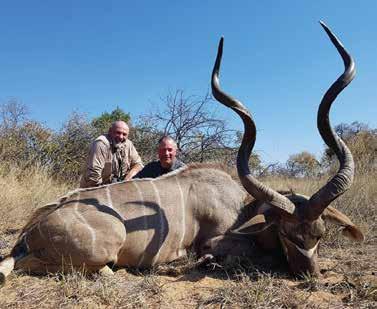











We want your pictures and stories both hunting and fishing
Send them in to us and we will select one each month for publication.
editor@thefishingpaper.co.nz
John Saladag picked up this 61cm Kahawai, his biggest fish yet whilst his Filipino friend landed this 42cm blue cod at Harrington point, Peninsula, Dunedin.
Tāne Johnson-Stephens got a new fishing rod and put it to great use at Lake Argyle ponds.
Out fishing with Dad Andy and brother Kobi , he caught his first ever Rainbow Trout . This beauty was filleted and cooked for dinner
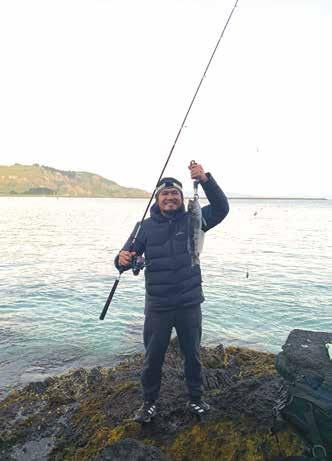


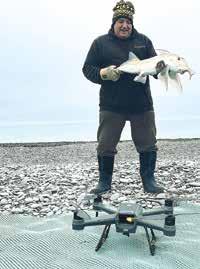

kid fishing Ladies trips - Game fishing for Sharks CALL AND BOOK A TRIP TODAY Mobile: +64 21 843 908 Email: info@topcatchcharters.co.nz






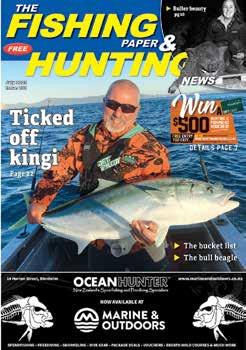










Fish Mainland looks forward to working with the new coalition Government. We are confident the new Government will instigate a real change to what South Island recreational fishers experienced this last political term.
For example, on October 5, the outgoing Labour Government announced marine protected areas (MPAs) to be established along the southeast region of the South Island. After three years of silence, such an announcement during the general election was unprecedented.
This announcement was a real blow to recreational and commercial fishers alike. It was the consequence of a $4million, multi-year, Department of Conservation-led planning process, with little regard for locals’ concerns.
First, DoC held its last public meeting on MPA planning in 2017 in Owaka, the Catlins. Locals were so incensed by the lack of substantive arguments for locking up longstanding fishing grounds, several expected a police presence was needed.
Second, DoC ceased holding public meetings and
selectively chose members of a MPA planning forum. To control behaviour and the process, DoC muzzled the forum members.
Third, public input was limited to formal consultation, last held in 2020, stacked in favour of DoC and like-minded nongovernment organisations that fully utilised media channels to pad the number of submissions in support of MPAs, despite most submitters outside the region having no understanding of the local situation.
The purpose was to focus Ministerial communications into a numbers game, those in support versus those objecting, with the latter communicated without the detail and emotion behind
real local concerns.
Fourth, it was apparent DoC did behind-the-scenes deals with Ngai Tahu to gain their support for the MPAs. Their support came through their agreed access to MPAs and ‘comanagement’ of them. We had no forewarning of such agreements, nor much in the way of subsequent explanation. Also, the boundaries for Type-2 MPAs have not been explained.
The public should have been fully informed of such material changes and provided opportunities to express their views; it is unacceptable the outgoing Government had such disregard for natural justice and due process.
In summary, the real culprit
Randall Besswas DoC being allowed to have undue influence in the MPA planning process and Ministerial communications but where was Fisheries New Zealand (MPI) and support for fishers?
Why did the MPA planning forum lack recreational fisher representation, which could have logically come from a longstanding Marine Recreational Forum in the region?
How could the MPA planning forum fail to respond to local fishers’ proposed MPA alternatives?
Southeast fishers consider much better decisions can be made about what areas need protection and in ways that minimise adverse impacts on existing users
and Treaty settlement obligations.
One way to bring about improvements is to better substantiate where recreational fishing occurs by collecting data on catch and e ort. For this purpose, Fish Mainland developed a recreational fisher self-reporting system aptly named Mainland Catch.
Fish Mainland is working with Datacom to further improve Mainland Catch.
The improvements will simplify its roll out to both IOS and Android platforms and provide a better user interface (app) for creating trips, adding fishers, and recording catches, while also providing both light and dark

modes to improve usability in bright sunlight conditions while at sea.
The new Mainland Catch app will improve performance and responsiveness and enable the secure capture and retention of data to allow detailed reporting, as well as support both English and Te Reo languages.
We encourage you to show your support for Fish Mainland by becoming a member for free and making donations via our website or bank account no 03-0823-0101056-000.
Have you downloaded the Mainland Catch App?


SCAN HERE TO DOWNLOAD OR TO LEARN MORE

My wife and I decided to take the opportunity for a early morning fish in Tasman Bay whilst Nana came over to look after the kids. We hit the water at 3:45am no wait at the ramp, hooned out to the radio tower just o the boulder bank. Dropped 3kg burly and waited. Tracy had a good hit but turned the drag the wrong way and lost her gear ( good lesson there ). I had a stray line out the back which proved to be the candy for snapper I pulled in 3 good size snapper and Tracy had not had a bite since she lost her gear…. It was just before high tide I dropped another 3kg burly and flicked the stray line out one last time as we had
plenty of fish.
Shannon ScolesI could see Tracy was gutted not having caught a fish, I said to her next time the stray line runs it’s all yours. Some time had past and then the reel started screaming so she took over.
It was an interesting fight, I was convinced it was a big ray or shark as there was no nodding of the rod, I knew it was big as Tracy was having trouble keeping the rod out of the water… eventually the fish surfaced.
I couldn’t believe my eyes it was huge fish which we struggled to pull on board. Whilst it was only 77cm long it weighed in at a whopping 22lb . A great personal best for Tracy and for our family.
If I had only known it was a 20lb fish I would of pulled it in myself as I am still to join the 20lb+ club.

Total Prize Value over $4250 Entry fees:
$20
$2
Kontiki $20
Tickets are available from : Knudson Sports & Toyworld
Seddonville Hotel
Mokihinui Pub N Grub
Ticket Prize Draws:
$100 for Juniors
$400 for Open and Kontiki sections
Whether you catch fish for a feed or buy it from your local market or fish and chip shop, there’s one thing that’s clear – we all want to know that our seafood comes from healthy fisheries that will continue to provide delicious kaimoana for future generations.
At Fisheries New Zealand, we’re always building on what we know about Aotearoa’s oceans and fisheries, and this includes improving our understanding of recreational fishing activity.
We know that around 600,000 people, or approximately 13 percent of New Zealand’s population, go recreational fishing in our waters annually.
Each year, NIWA gathers information on behalf of Fisheries New Zealand about recreational fishing practices and catch from popular fishing locations around the country. This summer they’ll have a team of people, many of them passionate fishers and members of local fishing clubs, doing interviews at boat ramps around the motu.
Fisheries New Zealand Principal Scientist Ian Tuck says the work provides
an important source of information about recreational fishing.
Heaviest Daily Fish Weighed Each Day $50
Heaviest Daily Snapper Weighed Each Day ................... $50
Heaviest Fish $300 Runner-up $100
Heaviest Snapper ..................$300 Runner Up .................................$100
Lucky Fish $300 Rod & Reel
Longest Fish $50 Cash & $100 Reel
Heaviest Trout
Runner-up
Heaviest Kahawai
Ladies Heaviest Fish
PLUS Junior and Electric Kontiki sections!
PLUS heaps more prizes
“We’ve had boat ramp surveys since the early 1990s – it’s one of the ways we get data on recreational fishing activity. This complements other research like the National Panel Survey, which is our largest recreational fishing survey, and area specific surveys where more detailed information is needed, such as sampling of catch during the recent recreational pāua season in Kaikōura".
“The interviewers will be asking fishers about their catch, and this information will help us determine the amount of fish in the area,
and on what catch and size limits should be".
“Our boat ramp interview days are spread throughout the year, on weekends, and midweek days to get a representative coverage of the fishery.”
This study, led by NIWA Fisheries Scientist Dr Jade Maggs, will focus mainly on the north-eastern coast of the North Island, as well as parts of the west coast and some areas of the South Island.
“All information collected is kept private. It’s only used to help inform how New Zealand’s fisheries are managed. We don’t share people’s secret fishing spots. We would just like to know a little about what you

Competition Area: Old Man Rock to Granity School
Thanks to our Sponsors and Supporters who include:
• Knudsen Sports & Toyworld
• LION Breweries
Mokihinui Pub N Grub
• Seddonville Hotel & Motel Units
• The Fishing Paper & Hunting News
caught, and how you caught it,” says Dr Maggs.
“The interviewers are not there to enforce the law, but only to collect scientific information. They will be asking fishers if they’d like to participate. If they agree, the interviewer will ask about their fishing activity, including what they caught that day, and take measurements of the fish caught.”
NIWA Chief Scientist Dr Richard O’Driscoll says knowing how many fish are taken out of the ocean is an important piece of the research puzzle.
“This includes the recreational catch, which in some areas is as high or
higher than the commercial take for species like snapper and blue cod.
“These surveys are a vital part of NIWA’s research on recreational fisheries that is funded by Fisheries New Zealand. NIWA began collecting data in 1991, so we’re building a valuable long-term dataset of population changes. But from year to year, we have di erent projects that require additional data".
"We encourage fishers to get involved with the survey – it’s easy, and anonymous, and you’ll be providing information to help manage your local fishery so it can continue to provide for future generations.”
Have your say on Kaikōura’s 2024 recreational pāua season, and catch limits for other fish stocks around Aotearoa
Fisheries New Zealand is asking for feedback on the timing and duration of Kaikōura’s next recreational pāua season.
This, along with proposed changes to catch limits and settings for a range of other fisheries, forms part of Fisheries New Zealand’s twice-yearly sustainability review.
“Kaikōura’s pāua fishery recovered well from the
damage caused by the 2016 earthquakes, and we want to see it remain healthy and abundant. Our options for the recreational season take a cautious approach to help ensure the fishery continues to provide for generations to come,” says Marianne Lukkien, acting Director Fisheries Management.
“We’d like to hear from anyone with an interest in this fishery, particularly the Kaikōura community who have important local knowledge and insights.
Local iwi, stakeholders, and the community have been integral to the recovery of this important shared fishery, and we welcome their support and feedback.”
Fisheries New Zealand
is also seeking feedback on catch settings for eight other fish stocks around the country, including spiny rock lobster.
Proposals are based on the best available information on what’s happening in the fisheries, including surveys, information from local fishers, and potential impacts from events like cyclones or marine heatwaves.
“This review includes proposals to increase catch allowances for six fish stocks where information suggests more fish can be sustainably harvested, and a precautionary reduction to catch limits for spiny rock lobster near Gisborne recognising the impacts of
recent extreme weather on coastal marine habitat.”
Stocks for this review are:
• Spiny rock lobster (CRA 3) – Gisborne
• Spiny rock lobster (CRA 7 & 8) – Otago, Southland, Stewart Island, and Fiordland
• Silver warehou SWA 4) – Southland, SubAntarctic, and the Chatham Rise Gemfish (SKI 3 & 7) –South Island and the Chatham Rise
• Southern bluefin tuna (STN 1) – all of New Zealand
• Pāua – recreational fishing season for the wider Kaikōura area
Once consultation closes,
Fisheries New Zealand will analyse the submissions and provide advice to the Minister for Oceans and Fisheries for consideration.
Changes will be announced by the start of the April fishing year on 1 April 2024.
"Consultation begins today, and we encourage everyone who has an interest in these fisheries to have their say”, says Marianne Lukkien.
Submissions can be made online until 5pm on 2 February 2024. More information including how to make a submission can be found here: https://www. mpi.govt.nz/consultations/ review-of-sustainabilitymeasures-2024-April-round


As a regular reader you might recall my tale of windy woe one Saturday, when the easterly almost blew me back to Greymouth. Irish optimism kept me out there persisting when most others would have flagged it. Fishing in an easterly for goodness sake! The day did improve, the wind died right down and West Coast sunshine brought quite the stellar day. There were no other craft out when I arrived, but later a boat came into my patch of H2O, straight towards me. It happened before when some dumko invaded the waters of a reach we were drifting down. It turned nasty as the ignoramus had no inkling of angler etiquette. The case comes up on
Tuesday!
Back to this story – the boat kept coming with two blokes on board plus a good-looking red dog. As they got even closer one of them called out, not the dog, “is that you Ivan?”
At that point I realised F&G were out doing their job, so I fossicked around in my wallet for my license, why do we have so many plastic cards these days? I handed
it to Rob and then we had a bit of a yarn as you do. Then they moved on to see who else was silly enough to be out in easterlies, while I continued piscatorial activities.
Optimism grew as the wind dropped and it flattened o , so I began to see fish in the sunlit waters and at one point there was a movement. Out went the fly, the finny critter had a quick
nip then stealthed rapidly to parts unknown. It began to be fun as more were sighted, then my phone’s ringtone sounded playing an old Four Jacks and a Jill song, so I knew it was our son Timothy calling from Funk Fish, Inglewood in the ‘Naki.
We were both on speaker phone so I could hear him rattling around in his kitchen prepping for their restaurant and takeaway shop and he could pick up the sound of jet skis and fizz boats now appearing. After a good yarn, fishing continued and I think he must’ve been a good omen, as there were fish everywhere.
Just after his call TWO fish simultaneously charged the fly. This was getting good.
Some of the brownies would look then turn away, so I contemplated changing fly or using a smaller pattern but thought one would take soon and it did. Great to see a nicely spotted Lake Brunner brownie up close again, so it was released from the net while it was still in the water with no need to handle it.
Drifting along a bit further an elongated dark
shape moved, followed by a good take, followed by a strategic mid-lake release! Things were warming up along with the temperatures and recalling something a mate once said, “fish where the fish are.”
I parked for a while and sight fished, with some trout so close, all that was needed was the leader flicked out.
First cast after lunchbreak there was another take, and this continued the program of catch and release until around 1.30pm when the trout went a bit quiet. I thought I couldn’t top this purple patch, so returned to the ramp.
On the way home I dropped in to see good mate Davey, who provided tea with local milk and their homegrown honey, plus a tour of their very extensive organic gardens and their exotic and native blended forest. Great end to a great day.
Fishers nabbed for too much snapper, undersize and excess pāua and fishing when banned Taking too much snapper, undersize and excess pāua, along with fishing when banned has landed some fishers with fines and community work.
A 53-year-old Pukekohe man was fined $3,000 and ordered to do 100 hours community work for having
The man had been fishing near Pakihi Island in the Hauraki Gulf in June 2023. When he was approached by a Fisheries New Zealand Fishery O cer and an Honorary Fishery O cer at the Kawakawa Bay Boat Club to do a catch inspection, he reacted by emptying a bin of caught fish into the water. The Fishery O cers retrieved most of the floating fish from the water. He was found with 48 snapper and 35 of these fish were undersize. The daily legal limit per person for snapper in Hauraki Gulf is seven with a minimum length of 30 cm.
for obstructing the Fishery O cers in their work by dumping the caught fish into the sea.
“The rules are there for a reason – to protect our shared fishing resources to ensure we have sustainable fisheries into the future,” says Fisheries New Zealand Director of Fisheries Compliance, Steve Ham.
A 31-year-old Blenheim man was fined $1,000 for being in possession of 57 pāua he gathered near Glasgow Island in the Marlborough Sounds. The man had his catch inspected
limit for ordinary pāua was 5 per person with a minimum size of 125mm. The man’s 38-year-old dive buddy was also fined $1000 during a separate court hearing.
A 40-year-old Northland man was ordered to do 100 hours community work for fishing while banned from fishing when he was sentenced in the Kaikohe District Court.
The man’s three-year prohibition from fishing was not due to end until August 2024. He was observed by Fishery O cers in January this year (2023) at Kawerua – a West Coast beach south
pāua behind a rock when he spotted Fishery O cers on the beach.
Fishery O cers retrieved the bag which were all undersize – less than 125mm. The daily limit for people legally able to harvest pāua is 10.
And a 47-year-old North Otago man was fined $1500 in the Oamaru District Court for having 54 shucked pāua he took from the Waianakarua river mouth in May this year (2023). The man was stopped by Fishery O cers in Oamaru. O cers found 35 of the shucked pāua were from shells that
The daily limit per person for pāua is 10.
“If you’re unsure of the fishing rules in the area you plan to fish – get the most up to date fishing rules by downloading the free NZ Fishing Rules mobile app. It will also work if you’re fishing in an area with limited mobile coverage,” says Steve Ham. Fisheries New Zealand encourages fishing industry operators and non-commercial fishers to report any suspected illegal activity through the Ministry for Primary Industries’ 0800 4










Some guys swear they’ve had more fun with their TAKACAT than their bigger boats.
I can vouch for that… my 3.8m fits in a couple of bags…takes about 7 minutes to inflate, and with the
wheel kit, it is easy to pull to the launch spot.
Mine has a 15hp PARSUN, which is max weight/power for its size. The cat design makes it super grippy, sitting as flat as a pancake on the turn.
It’s rugged, lightweight, easy to clean with heavy
duty material and additional protection on the scu zones.
You need to be wary of sharp objects that might create a small hole, so landing nets, bait boards, and gear boxes are good to have. Hooks tend to glance the heavy-duty material.





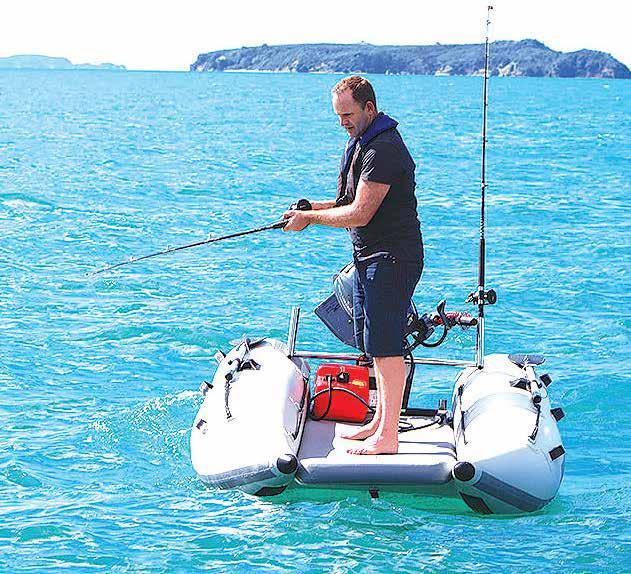
Bloke I know fancies
himself as a bit of a handyman and in his retirement has plenty of time on his hands to muck about in his workshop. Doesn’t matter who he chats to, he invariably o ers to make something, fix something, refurbish something or to give just whatever it is you might show him a tweak to make it go better. And he doesn’t do too bad a job either. Mind you he does have occasional failures, most by way of a lack of concentration on his part. He is easily distracted. Latest balls-up came when he o ered to sharpen the blades on his neighbour’s lawn mower. It was one of those jobbies with four short blades swinging on the end of a large disc. O come the blades, up onto the work bench and a few minutes of meticulous grinding. Blades went back on the mower done up finger tight for starters and then the spanner work started in earnest. One down tight, three to go and the phone rang. It was another neighbour needing a hand with a vehicle breakdown. O he
went in his truck to aid and assist.
Meanwhile the owner of the mower calls by to collect his machine. Has a quick look in the workshop, tilts the mower and sees the shiny edges on the blades and pushes it across the street to get started on his lawns. Two thirds along the first pass on the front yard the mower starts to vibrate, something flies out from under and smashes through the side of his house. The next piece of shrapnel hurtles into his fence before he shuts down the machine which was pretty much shaking itself to pieces. The two neighbours have yet to agree whose fault it was that the lawn mower is to all intents munted.

I’ve always been a fan of hunting and gathering my own food; it is cheaper, tastes better, is so much more rewarding, and is often food that you can’t buy in the supermarket.
While staying in Tekapo during my weekend o work, my poor uni student mindset couldn’t justify paying over $20 for one piece of ‘fresh’ salmon so I set o in search of fresh wild fish for dinner. My first stop was at the canals, which seemed to have far more fishermen than fish and yet, with that many people casting a wide variety of lures and baits, no one was catching anything. I still gave it a crack but quickly decided to move on and spent the rest of the morning hopping between lakes and rivers in the area. However, all I managed was a few snags and one brown trout following my lure in before disappearing as quick as he appeared. Despite it being midafternoon and 24 degrees, I carried on searching for new spots to fish until I spied a rocky outcrop on the edge of a crystal clear lake—it had potential, and no other fishermen.
Daniel CrimpI meandered down to the waters’ edge and rummaged through my tackle box. My eyes landed on a BlackMagic, black and gold dartspin—perfect.
The softbait danced along the rocky ground and quickly gained attention from a hungry brown trout, which came racing up to my feet before disturbing the water’s surface and vanishing. After a few more follows and moving around the lake a bit, I lobbed my lure out and within seconds my line was tight, as if the fish was waiting with its mouth wide open.
My reel screamed as the fish took o on multiple, powerful runs. If that wasn’t enough to get the blood pumping, it mixed in an emphatic display of acrobatics, leaping fully out of the water and violently shaking its head.
The battle was lengthy and honourable, but there had to be a victor and despite the fish’s best e orts, he eventually wore out and smoothly slid onto the rocks. I was over the moon with the fight and the fish, a beautiful threepound rainbow that was destined for the pan.
With the trout dispatched and gutted, I continued casting. Almost

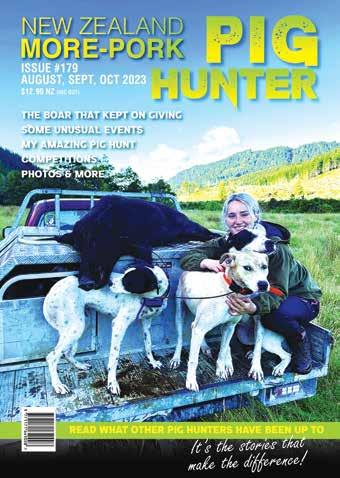
immediately after landing the first fish, I was on again. A battle ensued that was arguably more intense than the first yet had the same result, as I carefully landed another three-pound rainbow, identical to the last.
With one trout for me and my partner and one for her boss, I called it a day.
That evening we set up a makeshift car boot kitchen by the lake. The bright orange fillets were panfried with butter, lemon, a little bit of salt and pepper, and then topped with some fresh spring onions. A simple dinner but it was by far some of the tastiest fish I’ve ever had, far better
than anything from the supermarket.
Panfried trout
1 tbsp garlic infused olive oil
1 knob of butter
1 lemon
2 trout fillets
1 fresh spring onion
Salt and pepper to taste
Add butter and oil to a pan on medium to high heat and leave until the butter is foaming.
Cut the fillets into thirds and season liberally with salt and pepper.
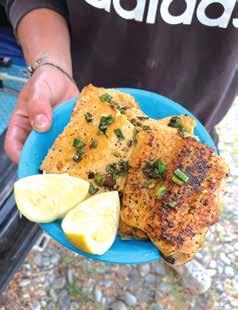
Fry each fillet till it’s golden on both sides.
Top with chopped spring onion and a squeeze of lemon juice.
Serve with steamed vegetables, mash potatoes, or a fresh green salad
After over 25 years in print - the owners are looking for a pig hunting enthusiast to purchase the magazine and continue its strong success. "It's the stories that make the difference"
